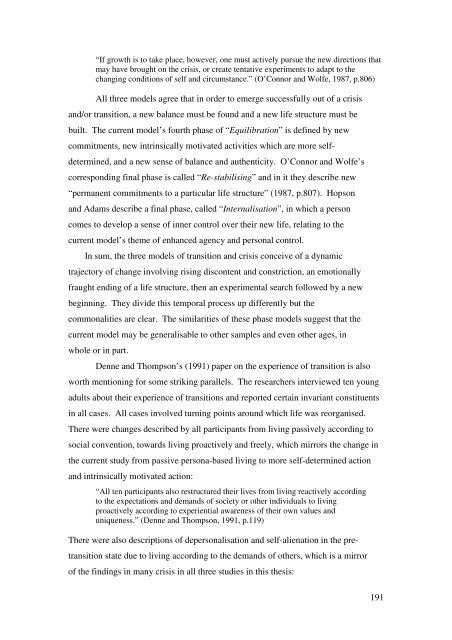DEVELOPMENTAL CRISIS IN EARLY ADULTHOOD: A ...
DEVELOPMENTAL CRISIS IN EARLY ADULTHOOD: A ...
DEVELOPMENTAL CRISIS IN EARLY ADULTHOOD: A ...
Create successful ePaper yourself
Turn your PDF publications into a flip-book with our unique Google optimized e-Paper software.
“If growth is to take place, however, one must actively pursue the new directions that<br />
may have brought on the crisis, or create tentative experiments to adapt to the<br />
changing conditions of self and circumstance.” (O’Connor and Wolfe, 1987, p.806)<br />
All three models agree that in order to emerge successfully out of a crisis<br />
and/or transition, a new balance must be found and a new life structure must be<br />
built. The current model’s fourth phase of “Equilibration” is defined by new<br />
commitments, new intrinsically motivated activities which are more selfdetermined,<br />
and a new sense of balance and authenticity. O’Connor and Wolfe’s<br />
corresponding final phase is called “Re-stabilising” and in it they describe new<br />
“permanent commitments to a particular life structure” (1987, p.807). Hopson<br />
and Adams describe a final phase, called “Internalisation”, in which a person<br />
comes to develop a sense of inner control over their new life, relating to the<br />
current model’s theme of enhanced agency and personal control.<br />
In sum, the three models of transition and crisis conceive of a dynamic<br />
trajectory of change involving rising discontent and constriction, an emotionally<br />
fraught ending of a life structure, then an experimental search followed by a new<br />
beginning. They divide this temporal process up differently but the<br />
commonalities are clear. The similarities of these phase models suggest that the<br />
current model may be generalisable to other samples and even other ages, in<br />
whole or in part.<br />
Denne and Thompson’s (1991) paper on the experience of transition is also<br />
worth mentioning for some striking parallels. The researchers interviewed ten young<br />
adults about their experience of transitions and reported certain invariant constituents<br />
in all cases. All cases involved turning points around which life was reorganised.<br />
There were changes described by all participants from living passively according to<br />
social convention, towards living proactively and freely, which mirrors the change in<br />
the current study from passive persona-based living to more self-determined action<br />
and intrinsically motivated action:<br />
“All ten participants also restructured their lives from living reactively according<br />
to the expectations and demands of society or other individuals to living<br />
proactively according to experiential awareness of their own values and<br />
uniqueness.” (Denne and Thompson, 1991, p.119)<br />
There were also descriptions of depersonalisation and self-alienation in the pretransition<br />
state due to living according to the demands of others, which is a mirror<br />
of the findings in many crisis in all three studies in this thesis:<br />
191
















